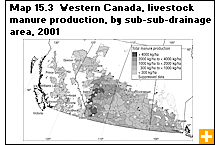Common menu bar links
Where might manure affect us?
Archived Content
Information identified as archived is provided for reference, research or recordkeeping purposes. It is not subject to the Government of Canada Web Standards and has not been altered or updated since it was archived. Please contact us to request a format other than those available.
Manure is a prime source of fertilizer for crops, one of the world’s oldest examples of recycling waste products. However, if not managed properly, manure can be a source of pollution. It is important to know not only where manure is produced, but also how it affects the surrounding drainage area.
Analysts determine this connection by using the geographic unit known as the sub-sub-drainage area (SSDA) to map livestock manure production, which they estimate from Census of Agriculture livestock numbers, to the surrounding catchment area.
The SSDA is valuable because it reflects fixed physical features of the land, rather than changing political or administrative boundaries. It also presents local information that is environmentally relevant. There are 978 SSDAs in Canada. In 2001, livestock production occurred in fewer than 400.
Manure production is concentrated in five major areas: central and southern Alberta, southern Manitoba, southern Ontario, southeastern Quebec and Prince Edward Island. Two other significant areas are the Lower Fraser Valley in British Columbia and the Annapolis area in Nova Scotia.
Ontario was home to the three highest manure-producing SSDAs in 2001. A high number of SSDAs in Alberta had the largest increases in manure production from 1981 to 2001. One-third of the manure produced in 2001 came from beef cows.
As part of a natural cycle, nitrogen in manure turns into a nitrate form, which can compromise drinking water and lead to human health problems. Phosphorus in manure can cause excessive algae growth in our lakes and streams, leaving them uninhabitable for fish and other aquatic life.



